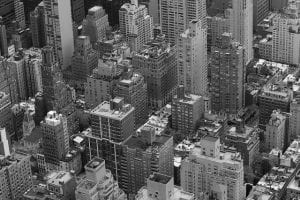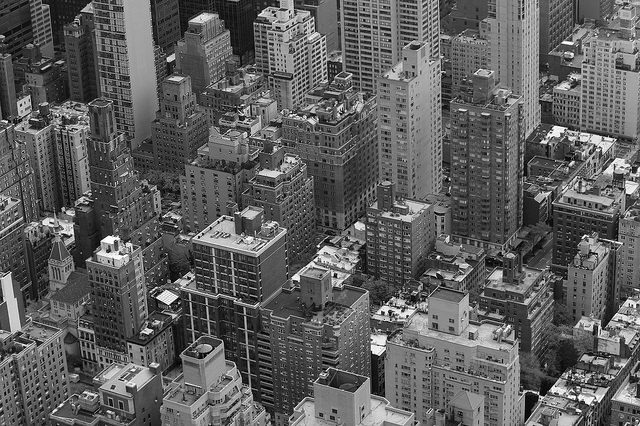
Photo by ‘Urbamaker’ via flickr, CC BY-NC-ND 2.0
New York City squatters were caught between their need for decent homes and a city bent on privatization.
When New York City police arrived around 9:30 a.m. on Tuesday, May 30, to carry out vacate orders for 541 and 545 East 13th Street, they were met by doors welded shut, barricades made of over-turned furniture and trash cans in the street, and 50 to 60 protesters forming a peaceful line in front of the buildings. The squatters facing eviction, joined by non-resident supporters, had been on the streets since 4 a.m., watching the barricades, chanting, and drumming on dumpsters.
Still in their homes for most of this year thanks to a November temporary restraining order against evictions, the squatters, also known as homesteaders, have been arguing in court for the right to stay in their homes by “adverse possession.” Adverse possession is a legal principle in common law giving people the right to keep someone else’s property if they have openly and notoriously used it for over 10 years without receiving a formal objection or notice to vacate. Many of the East 13th Street residents have been there for over 10 years, putting in long hours and hard work to make the buildings habitable, and they have documentation to prove the city was aware of their presence. “People have taken homes the city had turned its back on, and they have made them into real homes,” explains Mark Goldberg, a New York University student who was one of the 31 people arrested at the eviction.
The squatters comment that along with making the buildings habitable, they brought improvements to the neighborhood through a drop in the crime and drug traffic that had occurred in the empty buildings. Many neighbors agree. Social Historian Luc Sante, in a New York Times op-ed piece, claims these improvements, not a desire to build low-income housing, made the squatters’ buildings attractive to the city again after it had looked the other way for years. Stanley Cohen, a lawyer for the squatters, says the current practice of the city making a profit by selling off its housing stock makes their position in this case that much weaker.
The city has owned many buildings such as those on East 13th Street for decades after landlords abandoned them or they were seized for back taxes. Mayor Rudolph Guiliani’s policy on the buildings is to hand them to the private sector as quickly as possible, leaving tenants’ groups with questions about how community based the developers really are and how current tenants’ rights are going to be insured. The city is backing away from other tenant responsibilities as well by cutting services that act as a safety net against homelessness, encouraging rent deregulation, and neglecting to seize buildings for tax arrears. Cohen says all of these privatization policies cut away at the traditional argument against adverse possession claims, which is that the city takes responsibility to maintain public property for the common good.
From Evicting to Vacating
Against this political backdrop, spokespeople on both sides of the litigation over East 13th Street agree that the basic issue at stake is whether squatters have any rights. Before that could be decided, however, the city resorted to what some call pretexts in order to get the squatters out. This spring, Justice Elliott Wilk called a hearing to settle some factual disputes and take a wider look at the phenomenon of abandoned city-owned buildings. According to Cohen, when the city lost appeals to stop both the hearing and the restraining order, they “suddenly found [two of] the buildings to be unsafe.” On April 20 the city issued vacate orders for two of the buildings on East 13th Street, and the first floor of a third. Two other squats on the block were unaffected. The emergency vacate orders, based on walk-through inspections on Nov. 22, 1994, and April 12, 1995, claim there was “imminent danger to the safety and life of the occupants” from building collapse, and list troubles such as deteriorated joists, buckling walls, sagging floors, and disintegrating window lintels.
A sub-hearing over the legitimacy of these vacate orders pitted experts for both sides against each other and eclipsed the original hearing for several days. Cohen says the court found not only no danger of collapse or need to vacate the buildings, but found that “the [vacate] orders were a subterfuge to get around litigation, and the city’s witnesses were untruthful.” The court did recognize that certain repairs to the squats were needed, but said the work could be done with the people in place, and ordered the city to make a work plan to carry them out.
The city appealed this ruling as well, which made it ineffectual, for state law puts an automatic stay, or freeze, on any adverse ruling the city has appealed. The ruling remains in limbo because the appellate court postponed the case until September and would not lift the stay on its decision, even though it did not disagree or overturn anything from the trial court. Cohen says that in deciding not to decide, the court in effect told the city to proceed with the vacate orders at its own risk. The original restraining order is still in effect on all the buildings. “This is not the precedent [the city] was looking for,” says Matthew Lee, of Inner City Press/Community on the Move, a squatters’ group in the Bronx [see Shelterforce, May/June 1994, #75], because vacate orders are not specific to squatters; they can be issued against tenants and homeowners as well. Mara Neville, spokeswoman for the Department of Housing Preservation and Development, was very careful to point out that the city acted to carry out the vacate orders only, and was still respecting the restraining order against evictions. “May 30 was not an eviction,” she said. “It was the removal of occupants who refused to leave voluntarily.”
Police and Protests
The occupants certainly did not leave voluntarily or submissively, but they were very aware that their case was still pending in court, so they protested, using non-violent techniques such as forming a human chain and going limp when arrested. One squatter made soup to show he lived there and tried to share it with others on the street. The police used plastic cuffs when making their arrests, a sign that despite their show of force they believed the protesters were not dangerous. Yet Goldberg comments, “the police presence was excessive; they seemed ready to crush an armed rebellion. There were squads of officers in riot gear, helicopters, a tank, and a sniper across the street.” Witnesses also noted the presence of automatic weapons and the use of tear gas.
Especially disturbing to many was the police treatment of the media. Protest participant David Powell was told by network and independent media that “[the police] were dictating ‘you can cover this, you can’t cover that’… the [network] media’s crumb was that they got to know what would happen next.” Protesters found they could stand next to a camera operator to find out the next police move. Powell said network representatives were kept away from the confrontation and outside the barricades; one reporter was told “you can’t be in here” when she tried to enter the block. Network representatives mostly cooperated with police, but others were more determined, such as the eight people who stationed themselves with cameras on the fire escape of a supporter’s legal apartment. Police climbed up and forced them inside. “[The police] tried to stop any documentation of what they were doing,” says Powell.
Long Range Plans
Why the urgency to empty these buildings? Indeed, since last summer the city has had plans to renovate the block of East 13th Street squats to provide low-income housing. Neville says the block was chosen because it was the largest assemblage of contiguous “vacant” buildings in the area, and their renovation would “transform this corner of the lower east side.” Neville says the buildings were not chosen because they had squatters living in them, although she thinks under previous administrations the presence of the squatters actually prevented the renovations from being attempted.
Neville explained the redevelopment plan to begin “when” the city wins in court. The project would create 41 apartments, 12 of which would go to homeless families, and the rest of which would be available to families with incomes less than 60 percent of the area’s median. The sponsor of the project is the Lower East Side Coalition Housing Developing Corporation, which would purchase the space from the city at $500 per apartment. Matthew Lee of Inner City Press was skeptical of community development that necessitated evictions. “Any community development project you have to send a tank in to do is questionable,” he observed. Lee added he didn’t think the redevelopment project carried the backing of much of the community, an assessment with which Neville disagrees.
Various New York Times reports have mentioned that the East 13th Street squatters are mostly well-educated, employed artists. Goldberg says these characteristics alone do not mean the residents have the resources to live elsewhere. While many are employed, most can only find jobs that pay for food but not rent. “There may be people who have other options,” Goldberg commented, “but there are plenty of people [in the 13th Street squats] who don’t.” The residents may not have other options, but the city does, according to Powell. “On the very same block, and scores of blocks surrounding, there are dozens of abandoned buildings,” he says, concluding that the city’s claim to need these buildings for low-income housing “is obviously a lie to anyone who knows the area. They are relying on the public not to know.”
Powell also joins Sante in finding the claim suspect in light of the fact that the current administration has often shown itself to be more concerned with image than with housing its poor. Similarly, Paul DeRienzo of New York community radio station WBAI speculates that the city’s main concern in the case will be to maintain the sanctity of private property and prevent a “land rush” on city-owned buildings. Meanwhile, as the East 13th Street squatters double up with friends or crowd into other squats, they are looking to the continuing street protests and court battles to see if and when they can return home.



Comments